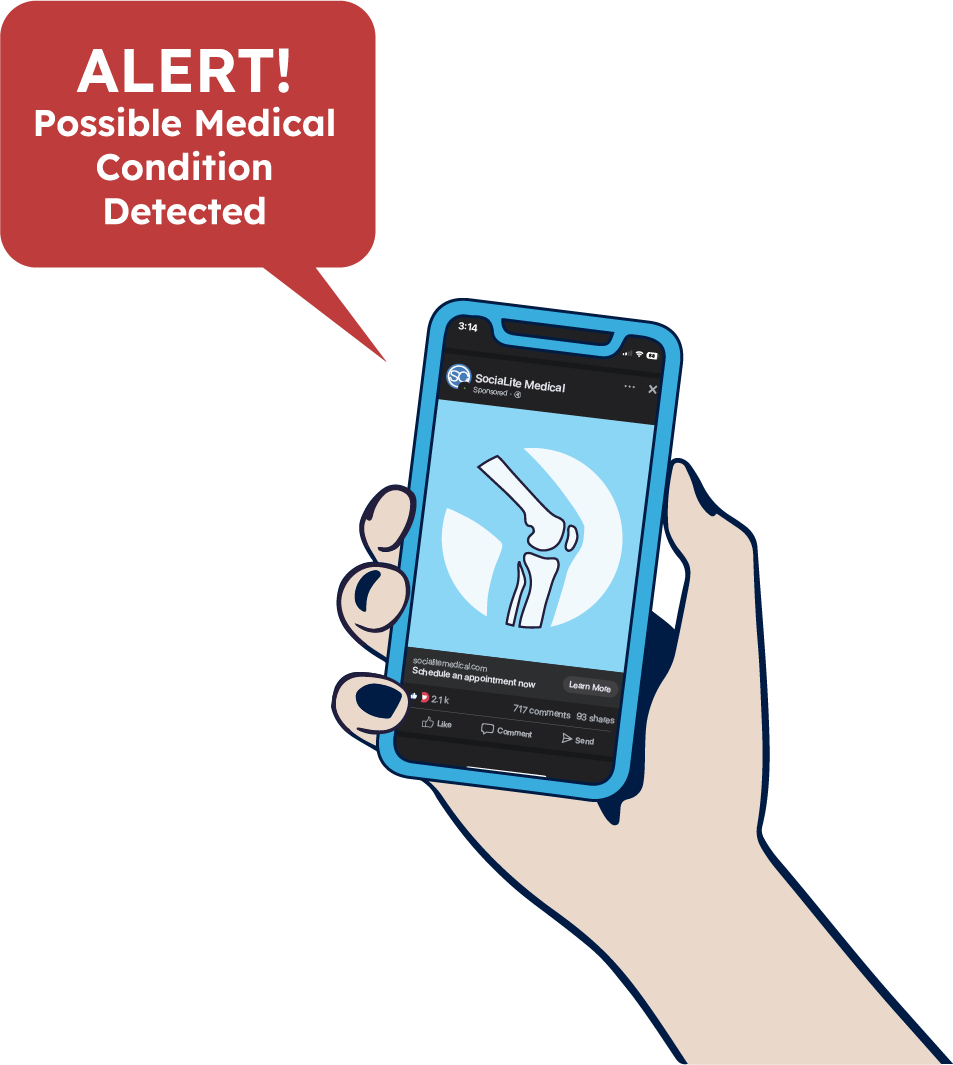It’s all too easy for healthcare providers to communicate with patients online. Yet, while every click, like, and share is an opportunity, there’s a delicate balance to strike. On one hand, you can connect with patients like never before. On the other, you hold in your hands sensitive data, including both Protected Health Information (PHI) and Individually Identifiable Health Information (IIHI).
The challenge here is ensuring that every marketing move you make aligns with the guidelines of the Health Insurance Portability and Accountability Act (HIPAA), all while being effective and innovative. As your digital marketing efforts grow, it’s crucial to understand the differences between PHI and IIHI. It’s also important to guarantee compliance with regulations across platforms such as Google Analytics, Google Ads, Facebook Ads, Bing Ads, and retargeting tools.
To do so, it’s not enough to only follow the rules. You also have to build and maintain patient trust so that every interaction feels genuine and respectful. With HIPAA-compliant marketing, it’s about crafting messages that not only resonate but also prioritize and uphold each patient’s privacy.
IIHI and PHI – What Is the Difference?
To create HIPAA-compliant marketing strategies, it’s necessary to understand IIHI and PHI. Though they might seem interchangeable, they are different, especially when it comes to their relationship with HIPAA.
The most prominent distinction between IIHI and PHI is the entity with which the data is associated. IIHI refers to health-related information that can potentially identify an individual. However, not all IIHI is covered by HIPAA. The deciding factor here is whether the information is associated with a covered entity subject to HIPAA regulations. In other words, if you have health-related information that is individually identifiable, but it’s not associated with a covered entity, it’s IIHI and not necessarily regulated by HIPAA.
PHI is a subset of IIHI. What makes it different is its direct association with covered entities or their business associates. It encompasses individually identifiable health data that are created, received, maintained, or transmitted by these entities. Because of this association, PHI is rigorously regulated by HIPAA, ensuring that this sensitive information is protected at every turn.
In essence, while all PHI is IIHI, not all IIHI is PHI. It’s the connection with HIPAA-regulated entities that makes all the difference. As the boundaries between personal and private blur, digital marketing brings with it the potential for misuse or accidental disclosure of sensitive information. However, clearly understanding what falls under PHI versus IIHI allows you to establish HIPAA-compliant marketing strategies that are effective and respectful of patient privacy.
Navigate Digital Channels with IIHI and PHI in Mind
Digital marketing opens up a wide range of opportunities but, when healthcare is in the mix, there’s an added layer of complexity. Each digital channel presents its set of challenges regarding these sensitive data types, and the stakes are high. Any missteps you make can ruin patient trust and even result in significant legal repercussions.
To truly benefit from the power of digital marketing in healthcare, you need to navigate these channels with a deep awareness of their potential and the unique challenges they present when it comes to IIHI and PHI. Beyond promoting your services and establishing a connection with patients, there’s an ever-present need to protect their confidential information.
 The foundation of HIPAA-compliant marketing practices is excluding any form of PHI or IIHI in your marketing campaigns and securing written consent before using patient testimonials, photos, or stories. It’s equally important to make sure that everyone on your digital marketing team is well-versed in HIPAA regulations, PHI, and IIHI. Regular education, ongoing monitoring, and frequent audits of your marketing efforts for compliance are crucial, especially as digital platforms constantly evolve.
The foundation of HIPAA-compliant marketing practices is excluding any form of PHI or IIHI in your marketing campaigns and securing written consent before using patient testimonials, photos, or stories. It’s equally important to make sure that everyone on your digital marketing team is well-versed in HIPAA regulations, PHI, and IIHI. Regular education, ongoing monitoring, and frequent audits of your marketing efforts for compliance are crucial, especially as digital platforms constantly evolve.
In addition to this, you need to pay attention to the specific considerations and guidelines for platforms like Google Analytics, Google Ads, Facebook Ads, Bing Ads, and effective retargeting techniques.
HIPAA-Smart Approach to Google Analytics
When using tracking platforms such as Google Analytics, you need to be careful and avoid disclosing PHI and IIHI. While Google Analytics isn’t HIPAA compliant, there are still things you can do to stay aligned with HIPAA’s guidelines.
Begin by using Google Analytics’ built-in feature to anonymize IP addresses, ensuring that no PHI is inadvertently captured. By default, Google Analytics tracks URLs, so it’s crucial to check that these URLs don’t contain any identifiable health information. Regularly audit your tracked URLs to guarantee they are free of any sensitive data. And, as a preventative measure, use the platform’s settings to disable the “Data Sharing” options, safeguarding against unintentional data sharing with third parties. As a result, you can effectively use Google Analytics while prioritizing patient privacy and embracing the principles of HIPAA-compliant marketing.
Create Safe Google Ads Campaigns
While Google offers a robust ad platform, it’s not tailored for HIPAA-compliant marketing. Yet, this doesn’t mean you should avoid it altogether.
When setting up healthcare-related campaigns, always double-check your ads and make sure neither the content nor the keywords contain any PHI or IIHI. While it might be tempting to use Google Ads’ personalized options, you must be careful. Put patient privacy as your top priority, ensuring you never accidentally reveal any sensitive health details.
Strike the Right Note with Facebook Ads in Healthcare
Facebook Ads pose unique challenges for healthcare providers. Recent developments prove that if you continue to use Facebook’s standard setup, you stand the chance of getting sued by users or patients and fined by the government.
However, this shouldn’t prevent you from using the platform for HIPAA-compliant marketing. Given Facebook’s intricate targeting capabilities, it’s crucial to avoid options that could identify individuals based on health or other sensitive criteria. Instead, favor broader categories that focus on general wellness or demographics, ensuring you avoid potential HIPAA pitfalls.
Effective and Compliant Bing Ads
Bing Ads might not be the first platform that comes to mind when considering online advertising, but its reach is undeniable. However, when it comes to HIPAA-compliant marketing, it requires the same meticulous approach as its counterparts.
Just like with Google Ads, make sure your Bing ad content steers clear of any suggestions or direct mentions of PHI or IIHI. Also, instead of focusing on a narrow audience, it’s wiser to use broad-match keywords. This not only widens your audience reach but also helps in preventing potential HIPAA breaches.
Retarget without Overstepping the Line
 Reminding users of their past interactions with your website can potentially draw them back, but in healthcare, this strategy poses unique challenges for HIPAA-compliant marketing.
Reminding users of their past interactions with your website can potentially draw them back, but in healthcare, this strategy poses unique challenges for HIPAA-compliant marketing.
Imagine a user visiting a page about a specific medical condition, and suddenly, retargeted ads hint at their possible health concerns. Such scenarios can inadvertently imply they have that particular condition, which can be a significant breach of privacy.
The safest route here is to focus on general health and wellness topics when retargeting. This ensures that users aren’t inadvertently singled out based on sensitive information or potential health conditions. This way, you can use the power of retargeting while respecting patient confidentiality and HIPAA guidelines.
Balance Outreach with Oversight
With a solid grasp of PHI, IIHI, and their implications in digital marketing, you can confidently navigate the challenges of HIPAA-compliant marketing. Digital marketing in the healthcare sphere isn’t just possible — it can be powerfully effective when approached with the right considerations. It’s essential to understand that HIPAA compliance doesn’t stifle innovation or outreach. Instead, it guides these processes to prioritize patient safety and confidentiality.
A foundational step in ensuring HIPAA-compliant marketing is partnering with vendors and platforms that understand the nuances of healthcare data. Before engaging in any digital partnership, make sure that the company is willing to sign a BAA. At the same time, be careful of platforms or vendors that avoid or dismiss the importance of a BAA. Passing or storing PHI data without strict security measures isn’t just a potential HIPAA violation, it’s a breach of trust with your patients and can lead to reputational damages and substantial penalties.
In the ever-evolving digital landscape, the key is to be proactive. Actively seek partners who not only excel in their domain, but also respect and uphold the sanctity of patient information. As a transformative healthcare marketing platform built in line with HIPAA standards, SocialClimb empowers you to attract, convert, and retain patients in the digital age while making sure that patient trust remains at the heart of every strategy, campaign, and interaction. With a combination of advanced marketing tools and data-driven insights, you can strengthen your reach and promote patient-centered and HIPAA-compliant marketing in healthcare.











